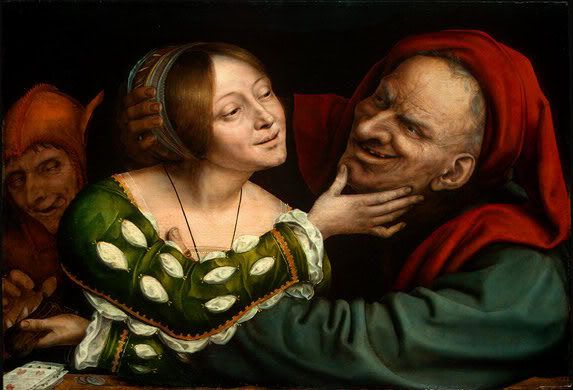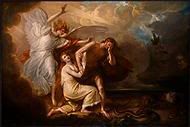 "Ill-Matched Lovers" Quentin Massys 1520/1525 oil on canvas.
"Ill-Matched Lovers" Quentin Massys 1520/1525 oil on canvas.  "The Expulsion of Adam and Eve from Paradise" Benjamin West, 1791, oil on panel.
"The Expulsion of Adam and Eve from Paradise" Benjamin West, 1791, oil on panel.This essay is an essay discussing the similarities and contrasts of two paintings, “Ill-Matched Lovers” oil on canvas, created by Dutch painter Quentin Massys in the year 1520/1525 and “The Expulsion of Adam and Eve from Paradise” oil on panel painted by American, Benjamin West in 1791. Quentin Massys’s painting was created during the Northern Renaissance period. This period evolved gradually out of the late Middle Ages, as artists became increasingly entranced with the myriad details of the visible world and better and better at capturing them (Getlein, 411). Benjamin West’s painting was created during the Baroque era. This era contrasts with the renaissance period because whereas Renaissance art stressed the calm of reason, Baroque art is full of emotion, energy, and movement (Getlein, 421). The style of these two paintings is representational. In this essay we will further discuss the subject matter, design, mood, medium and technique, and that went into the creation of the art.
These paintings have an interesting and similar subject matter. The subject matter is the objects or event that the work depicts (Getlein, 36). Lust is often portrayed as evil and taboo, and often the downfall of mankind. Massys painting doesn’t depict a historical story; yet it has a similar theme as classic stories. West utilizes stories and history, as well as sacred realm. Both paintings depict a classic story of a woman tempting a man, the man succumbing to the woman, and the consequence for their action. Massys paints a story of a woman tempting a man with sexual favors; while the man is overcome by lust for her he is unaware her accomplice is stealing his coin purse. West portrays a historical and biblical depiction of an Angel casting Adam and Eve out of the Garden of Eden. The classic story behind this scene is Eve tempting Adam to eat from the forbidden fruit, Adam succumbs, and they are forever cast out of paradise. Both paintings represent a woman tempting a man, the man succumbing to the woman, and a consequence for their actions. Sacred Realm is depicted in the West’s entire painting. The Garden of Eden has been deemed a holy land given too man from God. Also, notice that a light shines through the clouds onto the Angel. This is a representation of Heaven. The theme builds the mood of the paintings. Massys painting brings forth the mood of treachery and evilness. Not only because the man is stealing the coin purse, but also the man lusting after the woman, has the face of a predator. His features are not soft and innocent; rather they are rough and callous. Similarly the facial expression on Adam and Eve in West’s piece show the mood is full of sorrow and pain. Adam covering his face in shame adds strong emotion to the painting. These artists have interesting and unique subject and mood in their paintings.
The paintings utilize elements of design. A similarity between these artists is that they employ the use of value. Value is the variation of lights and darks (Getlein 92). Notice Massy’s employed value by painting the characters features and clothing in lighter colors in contrast with the dark background. West uses value in a similar way by painting the Angel, Adam, and Eve in shades of white and tints of orange while fading the background out into tints of black and grey. Shade is when the color is darker than the hue’s normal value (Getlein 96). Tint is when the color used is lighter than the hue’s normal value (Getlein 96). Another element of design used by Massys is color harmony. A color harmony is the selective use of two or more colors in a single composition (Getlein, 96). Notice the deep contrast of the man’s red hood to his clothing, as well as the woman’s soft green and white clothing. These artists use the principles of design to create interesting paintings. Emphasis is apparent in both paintings. Emphasis means that our attention is drawn more to certain parts of the composition than to others (Getlein, 134). In Massys piece the woman becomes the focal point because her dress and complexion deeply contrast with the other characters. She has a clear complexion and is dressed in cool colors; the victim and accomplice have ruddy complexions and are dressed in warm colors. This emphasis draws the viewer’s eye to accomplice in action. Benjamin West employs emphasis in color by painting the Angel, Adam, and Eve in light shades compared to the surroundings that are painted dark shades of grey. It makes this scene the focal point and draws the viewer sight to the expulsion. The artists also use balance and hierarchical scale. Balance is defined as the equal distribution of visual weight; the apparent “heaviness” or “lightness” of the forms arranged in a composition” (Getlein, 125). Massys employs balance by strategically placing a deck of cards below the action of the scene. The contrast of the dark coin purse above the deck of cards brings the viewers attention to the crime. Hierarchical scale is the use of scale to indicate relative importance (Getlein, 138). In West’s piece the light coming from the clouds crosses the top of the angel who is above the man, who is above the woman. This emphasizes the hierarchy of the heavens over the angel, the angel over mankind. The use of principles of design helped these artists create excellent paintings
In 1520/1525 Quentin Massys created “Ill-Matched Lovers” using oil on canvas. Benjamin West used Oil as well, on panel. Oil painting came about in the 15th century. Oil painting is the process of painting with pigments that are bound with a medium of drying oil, typically linseed oil. Oil paint dries very slowly, which allows the painter to blend colors by layering. Both artists created their painting using layering. Massy used layering to create realistic characters. The complexion’s have multiple colors, making the faces more realistic. He may have employed glazes. Glazes are thin and translucent veils of color applied over the thicker under painting (Getlein, 175). Massys painting is has a smooth appearance. Similarly, West uses layering in his painting to give it a realistic appeal. The clouds are painted with a range of beige, orange, and white colors that are thickly painted using Impasto technique. Impasto is a technique when paint is thickly layered on canvas (Getlein, 175). In contrast to Massys smooth finished painting, this effect of brush strokes makes West’s piece dramatic and unique. Even though both paintings create different images, the artists employed the same mediums of using layering and brush strokes. A difference in technique is used due to one being on canvas and the other on panel. Massys most likely utilized the traditional canvas which is made of linen and coated with animal glue prior to painting. In contrast West used panel which would have to be prepared with gesso. Gesso is a mixture of white pigment and glue that sealed the wood and could be sanded and rubbed to a smooth, ivory like finish (Getlein, 172). This technique helped create these unique artworks.
The style of a painting is an important factor when trying to understand how an artist created their art. Style in art, means the sum of such characteristics associated with a particular artist, group, or culture, or with an artist work at a specific time (Getlein, 587). Even though these artists hail from different movements and periods, both artists use representational style and naturalistic appearance. Representational is a form of art that presents the world in such way that we recognize a likeness (Getlein, 29). The style makes Massys painting natural, but the theme does as well. As previously explained, the man being distracted by lust gets his purse stolen by the woman’s accomplice. Lust, men, women, and thieves are historical and are easily recognized in life and in art. “These paintings use strong visual appearance, the bodies are painted to reveal light and shadow, and reflect the inner structure of bone and muscle, and how the clothing naturally drapes on the characters. These are the signs of naturalistic appearance (Getlein, 29). The emotion, energy, and movement are apparent in West’s depiction. The look on Adam and Eve’s faces it etched with anguish and despair. This painting also presents the world in a recognizable way with the features and bodies of Adam and Eve painted realistically with light and shadows. It is also representational because the historical aspect of this biblical story. The naturalistic appearance is evident in the detail of the bodies, faces, and surrounding of this painting.
In conclusion, I chose these two painting specifically because of the similar idea behind them. Originally, I only saw the similarity of a woman tempting a man. Throughout this course I have been able to learn and analyze the two paintings more intelligently and accurate. I have realized the unique differences and similarities these two painting share. I will continue to take forth this fascinating experience as I venture into analyzing other artwork. Through this experience I learned that a lot more that a paint brush and canvas go into creating a masterpiece. An artist has to think about and employ subject matter, design, mood, medium and technique went into the creating their art.
Sources:
Getlein, Mark. Living With Art; Eighth Edition. New York: McGraw-Hill 2008
“Ill-Matched Lovers” and “The Expulsion of Adam and Eve from Paradise” The Collection. National Gallery of Art 4th February 2008 http://www.nga.gov
Copyright 2007 National Gallery of Art Washington, DC






